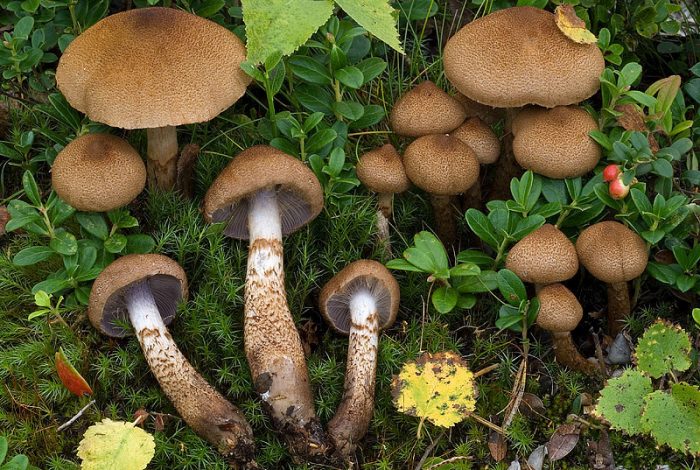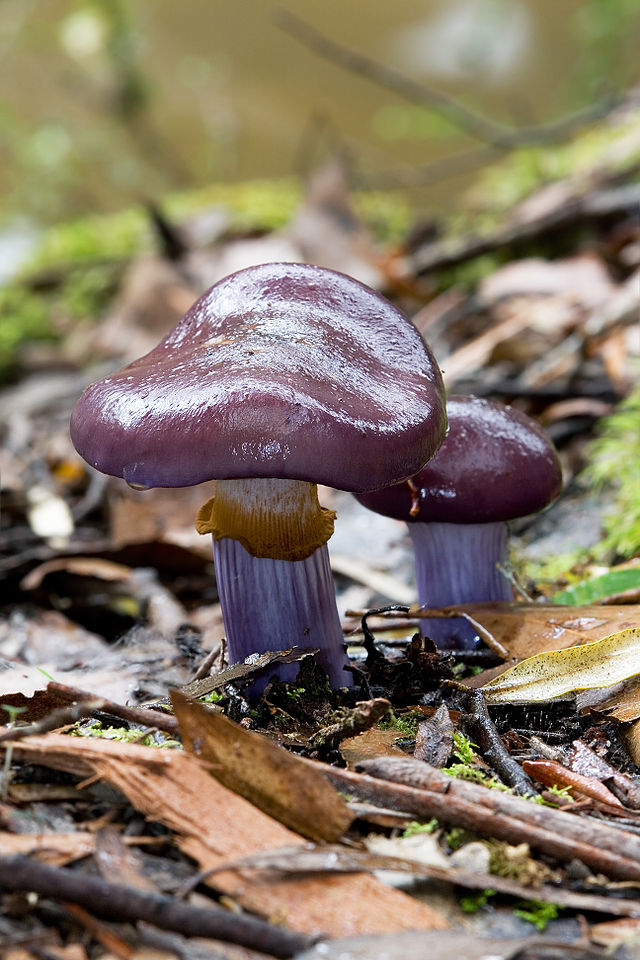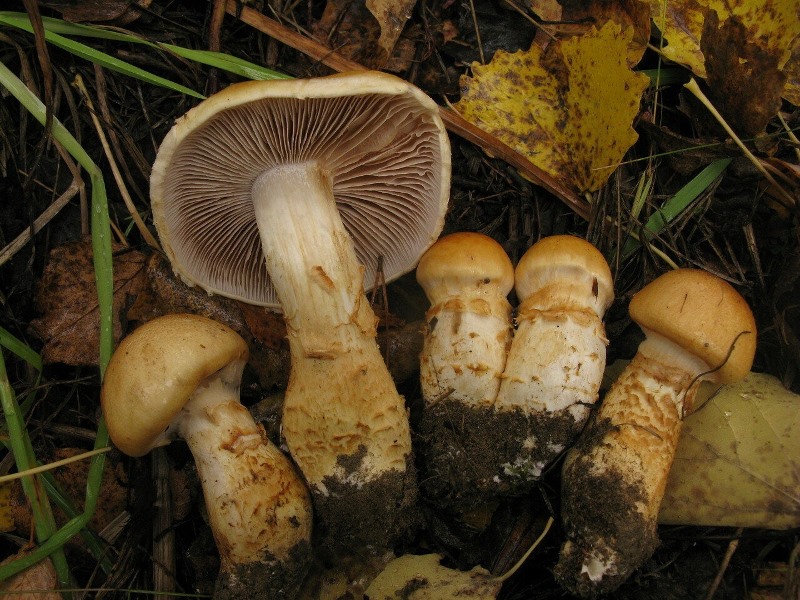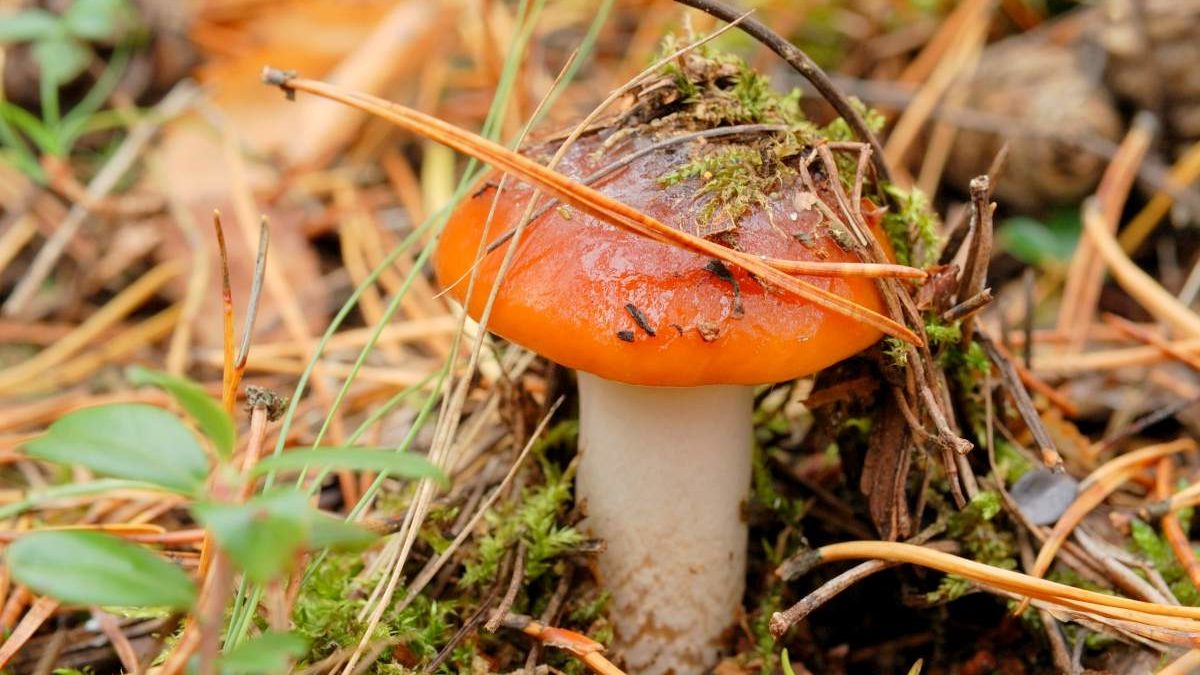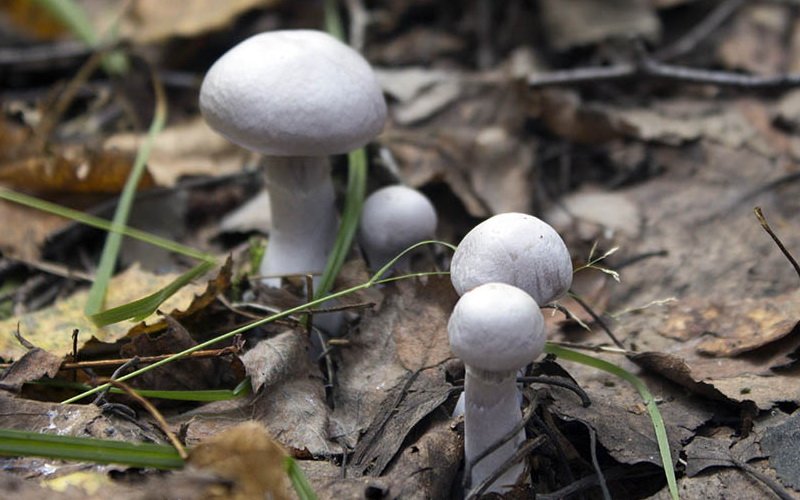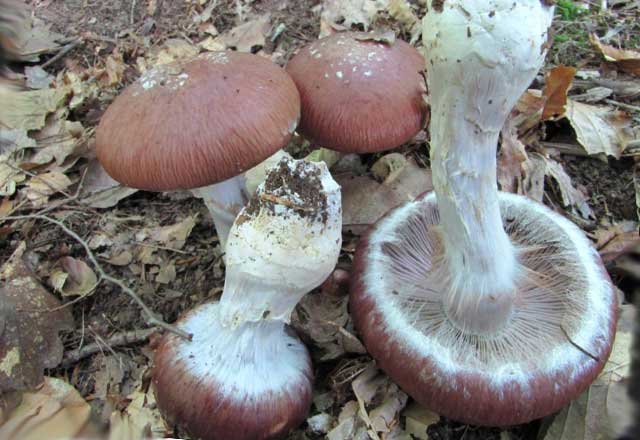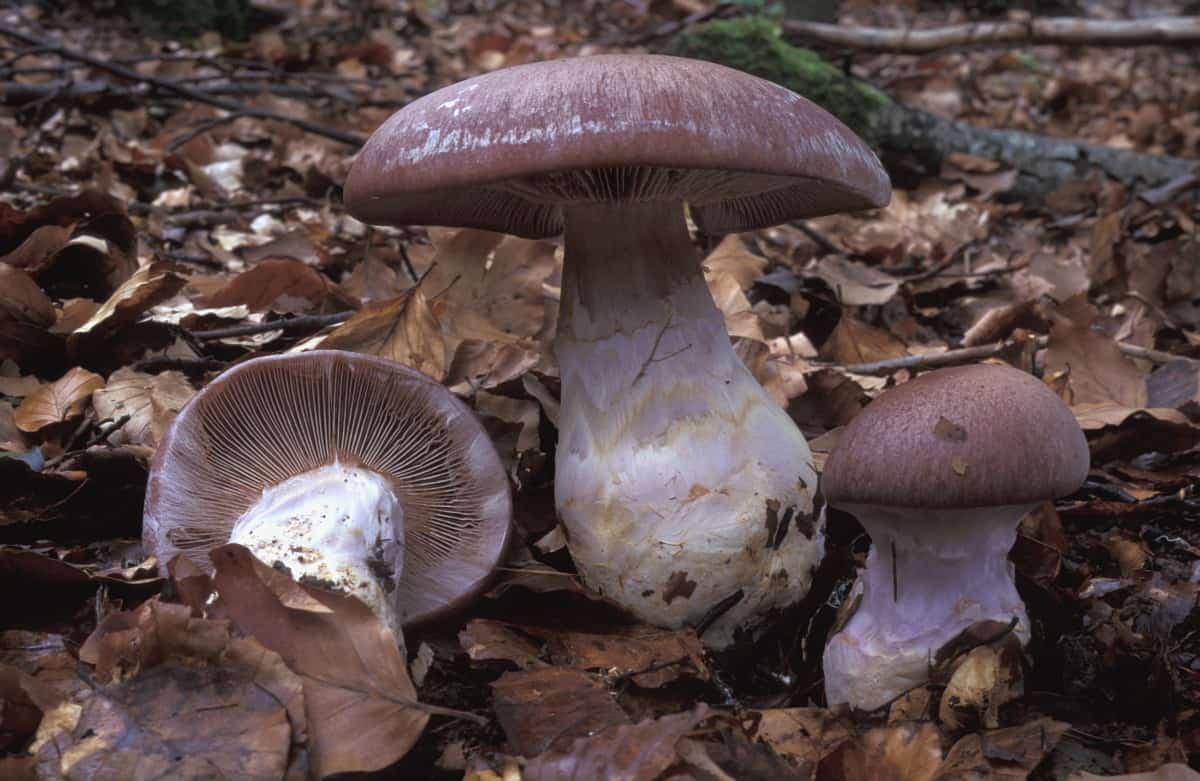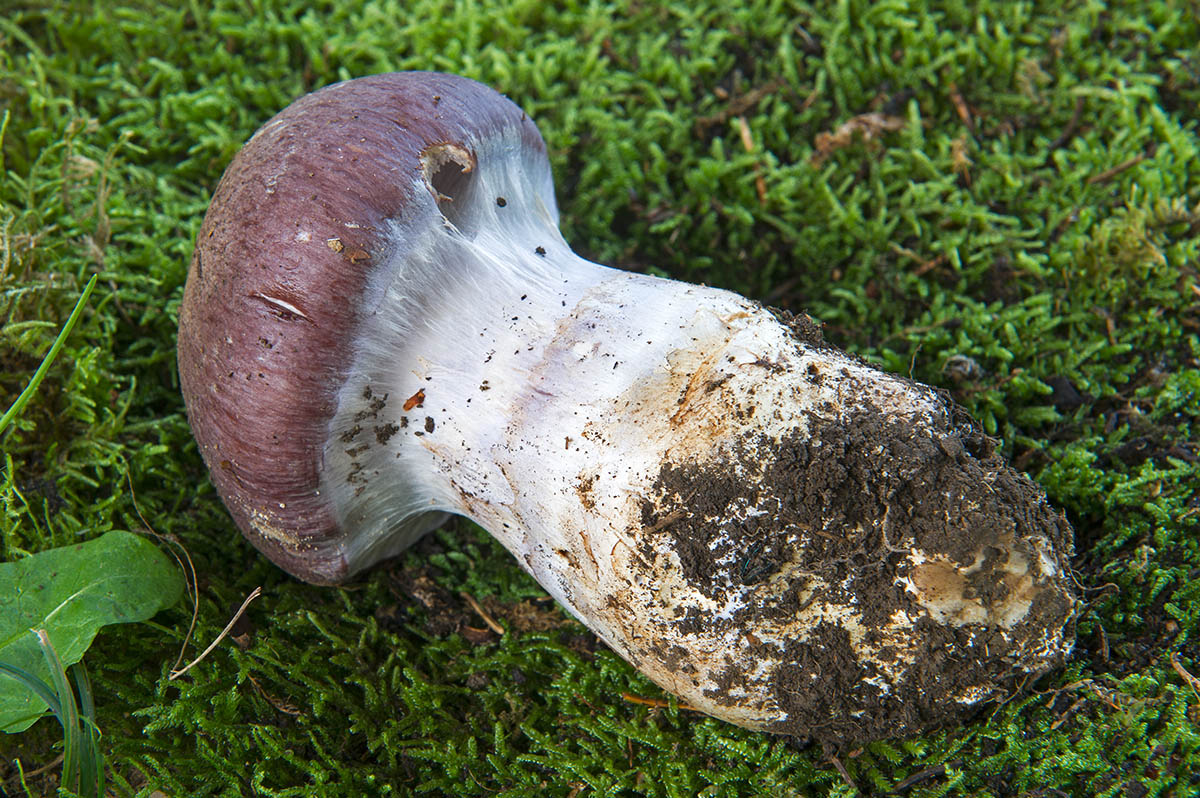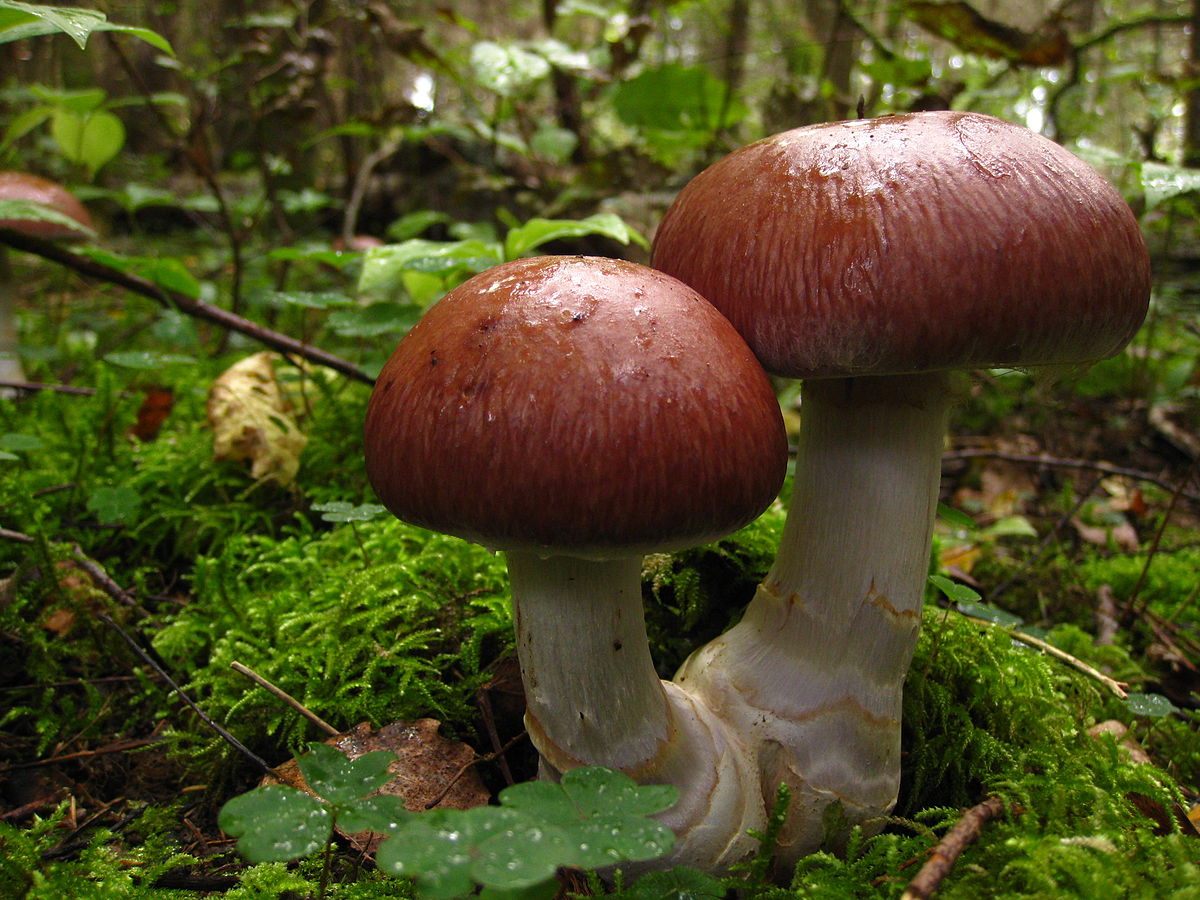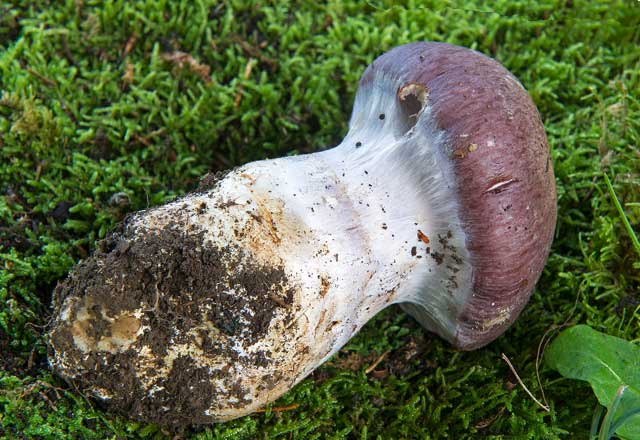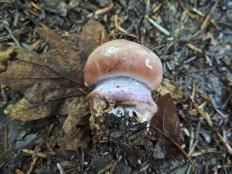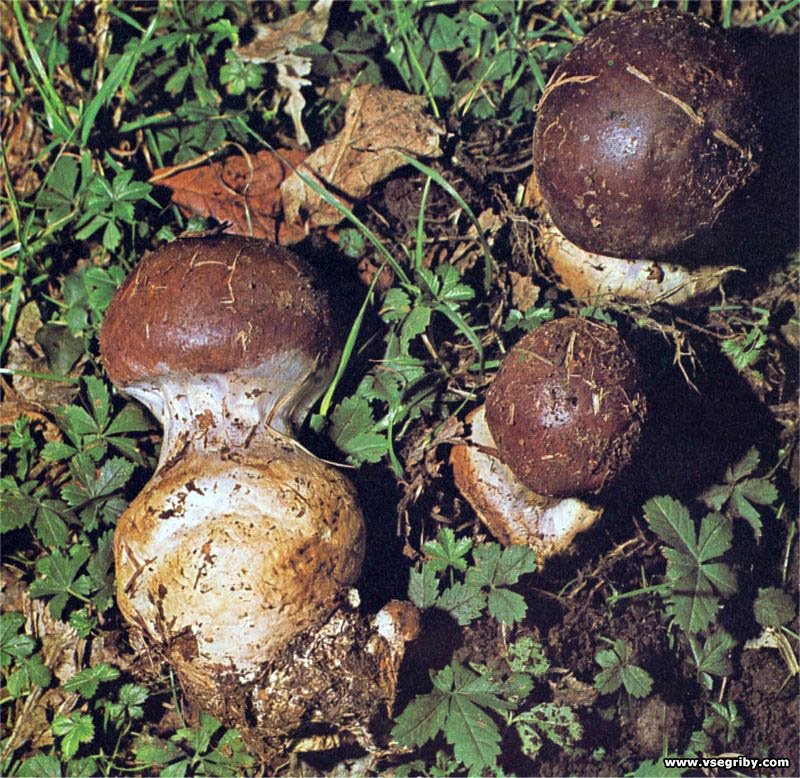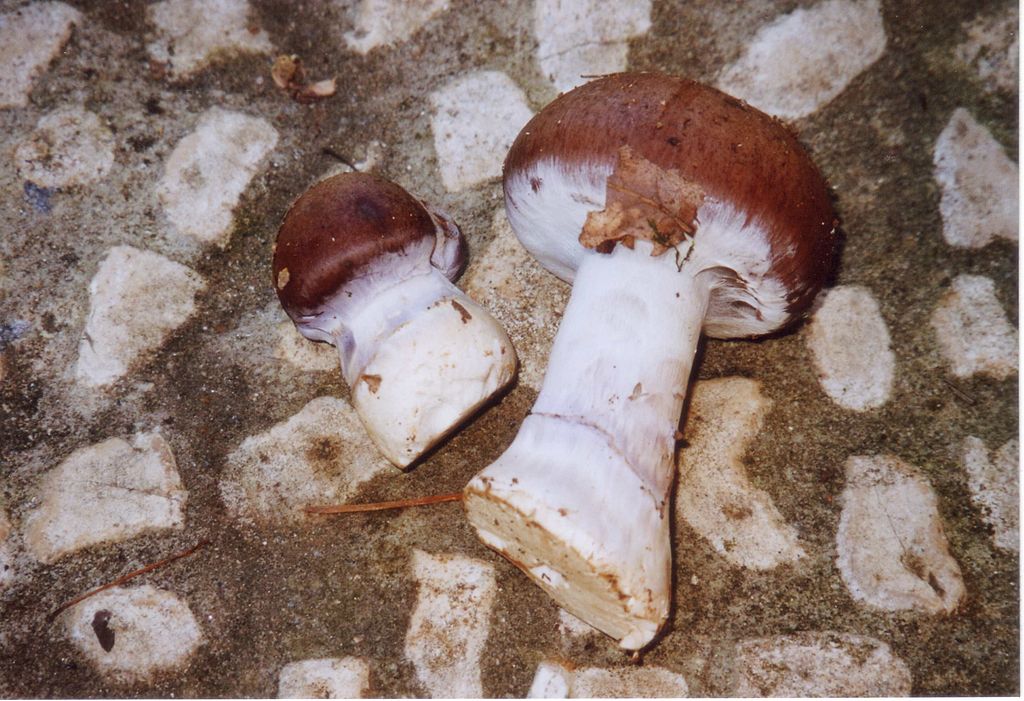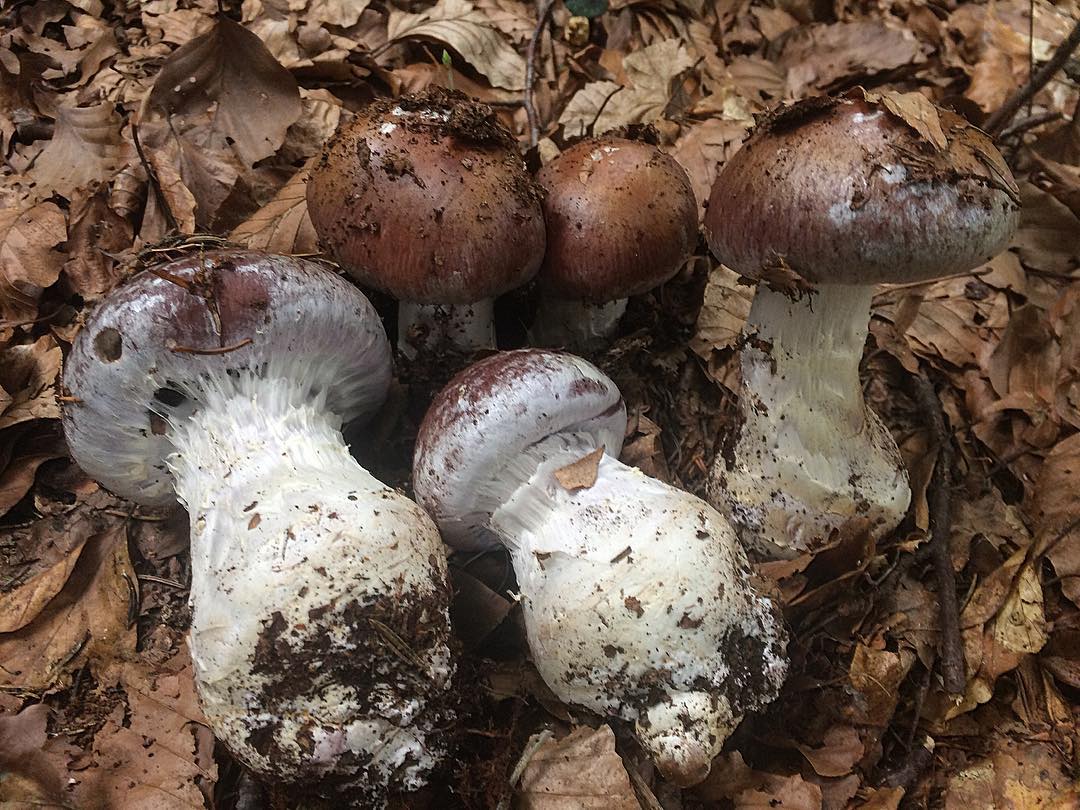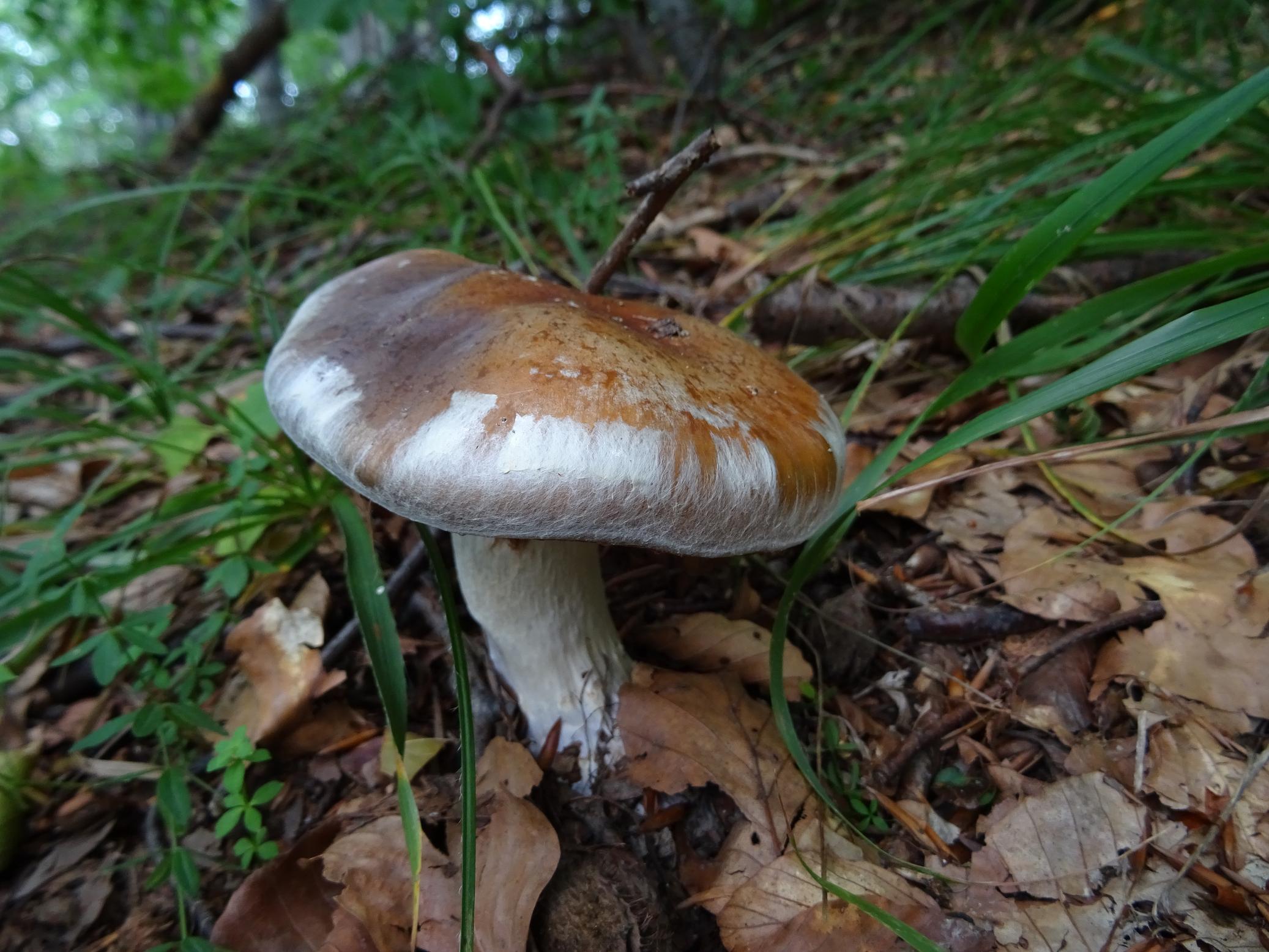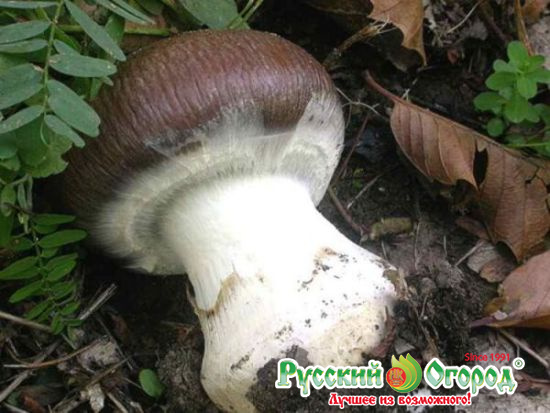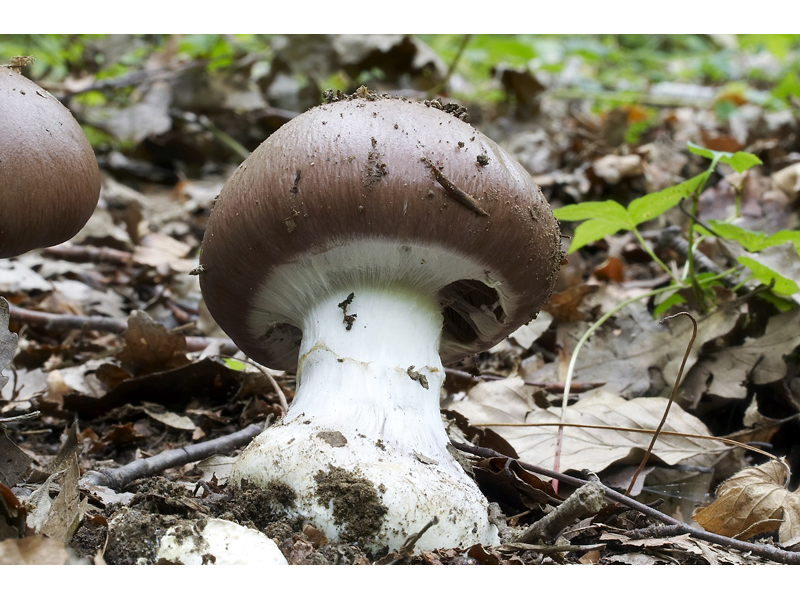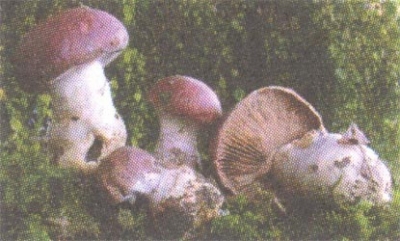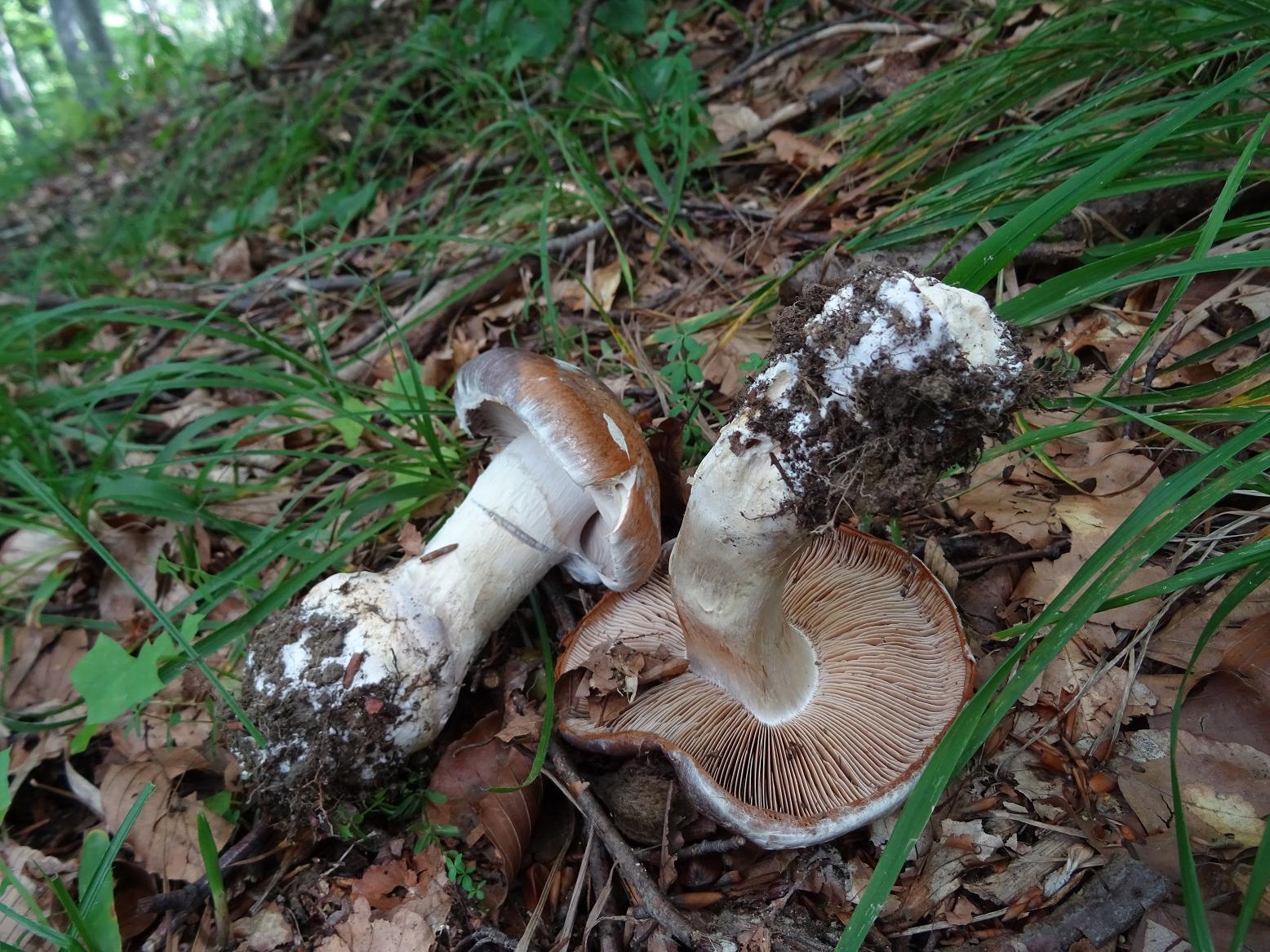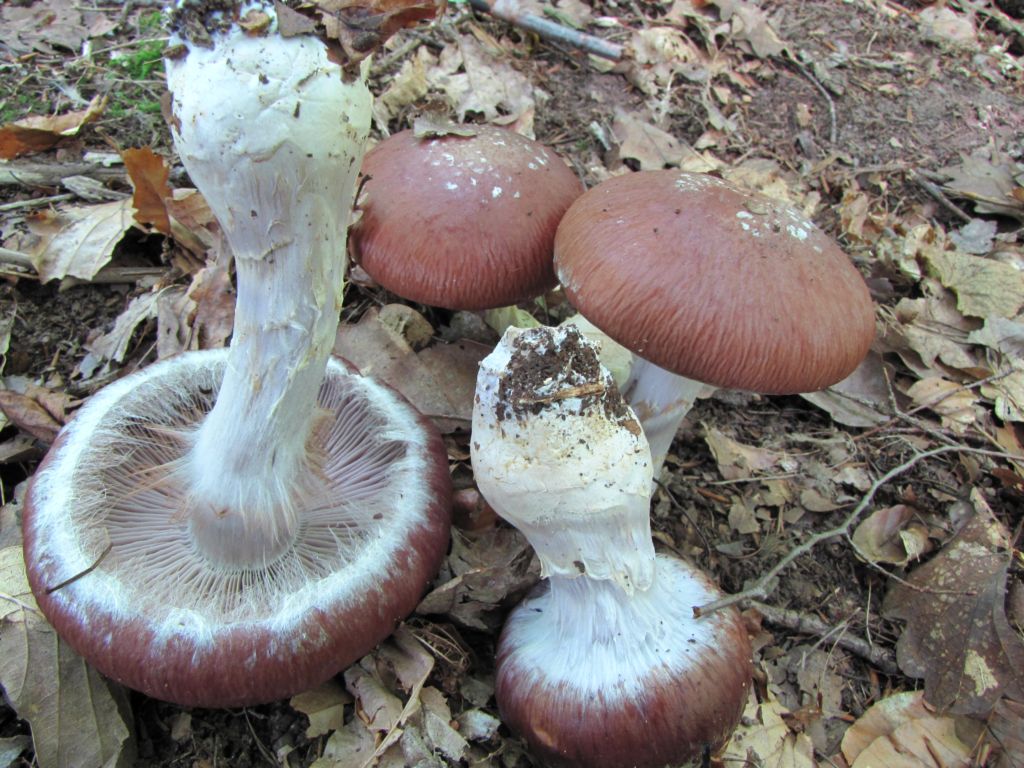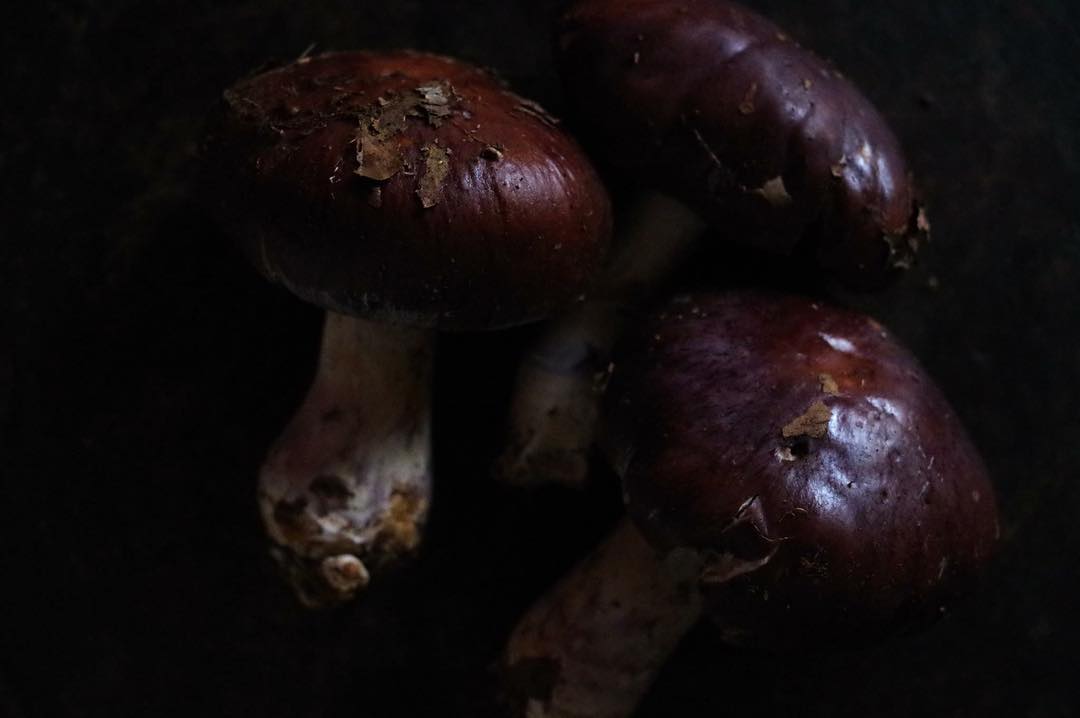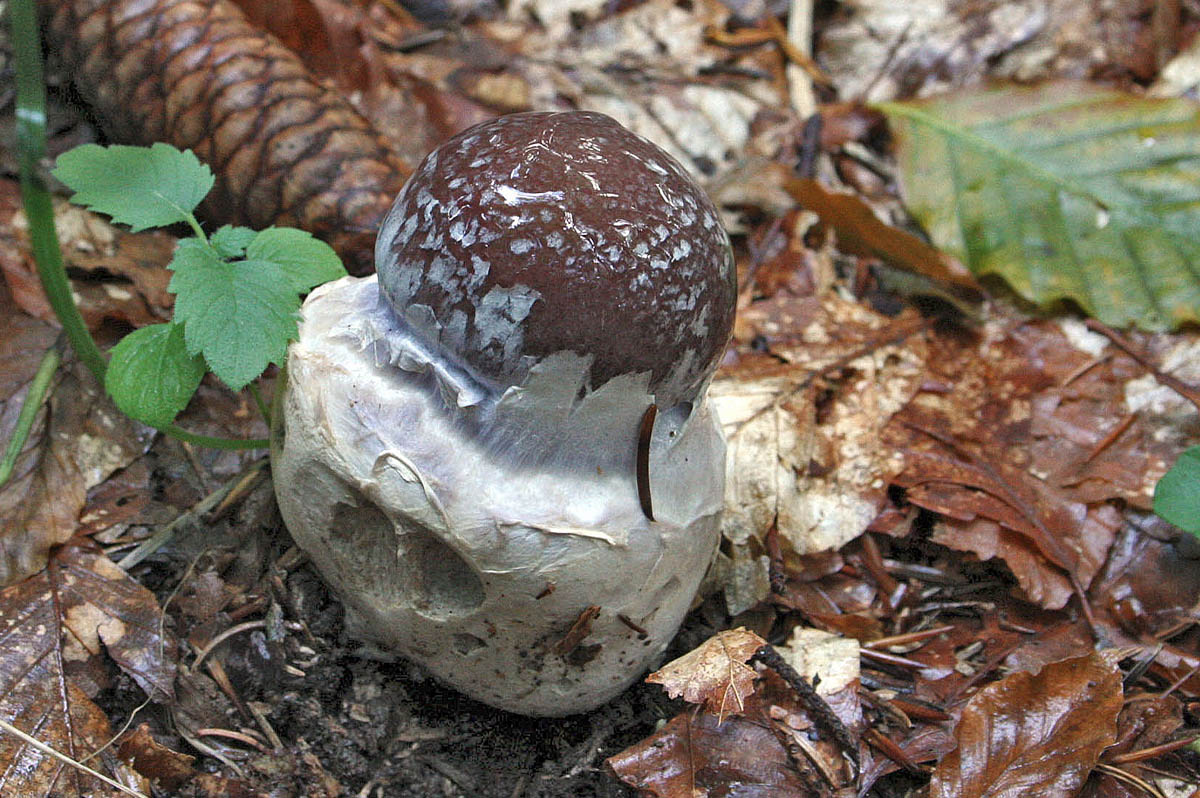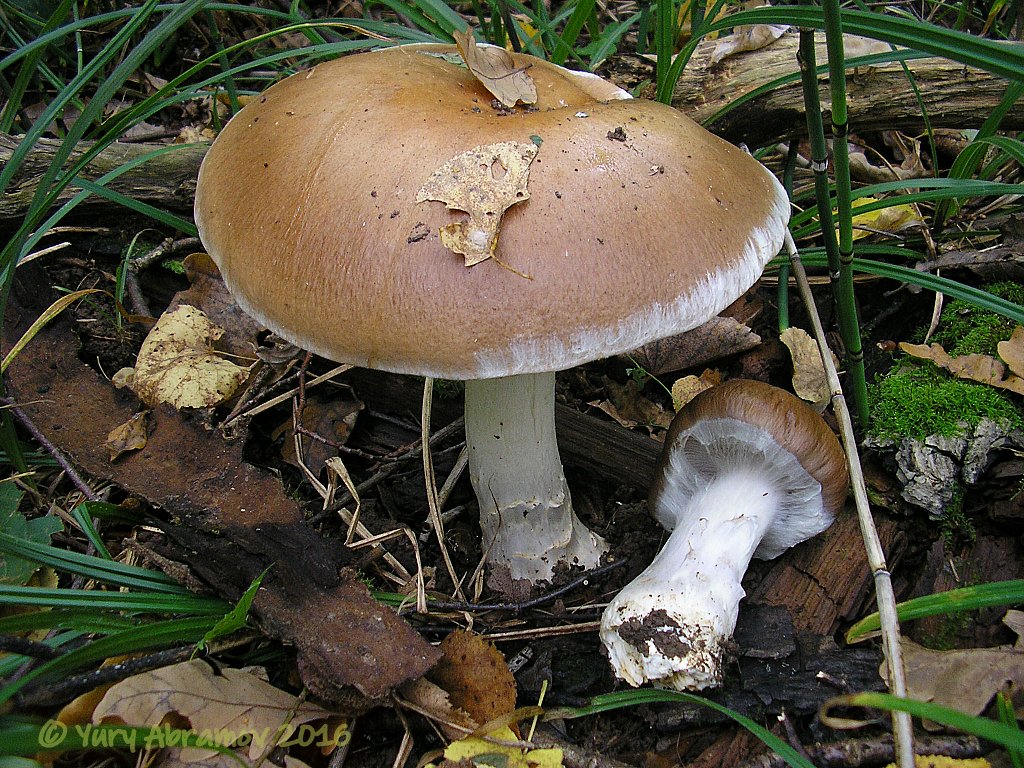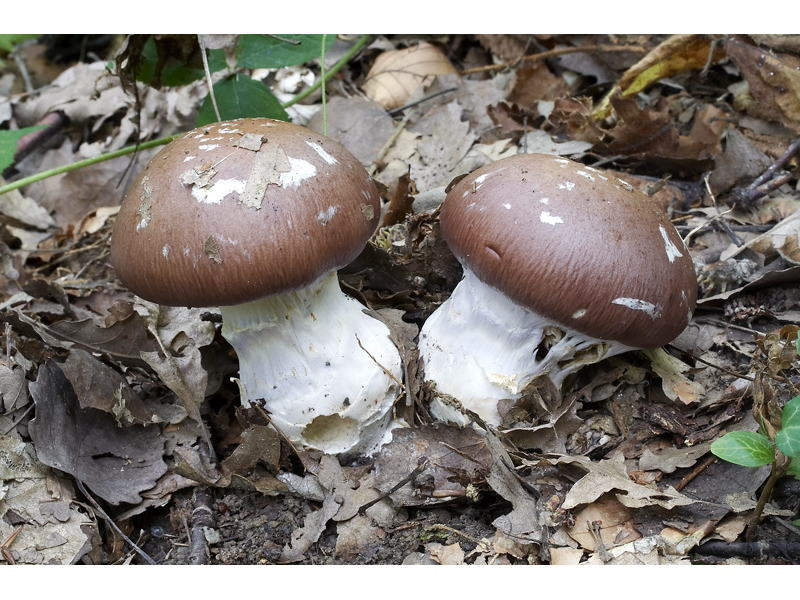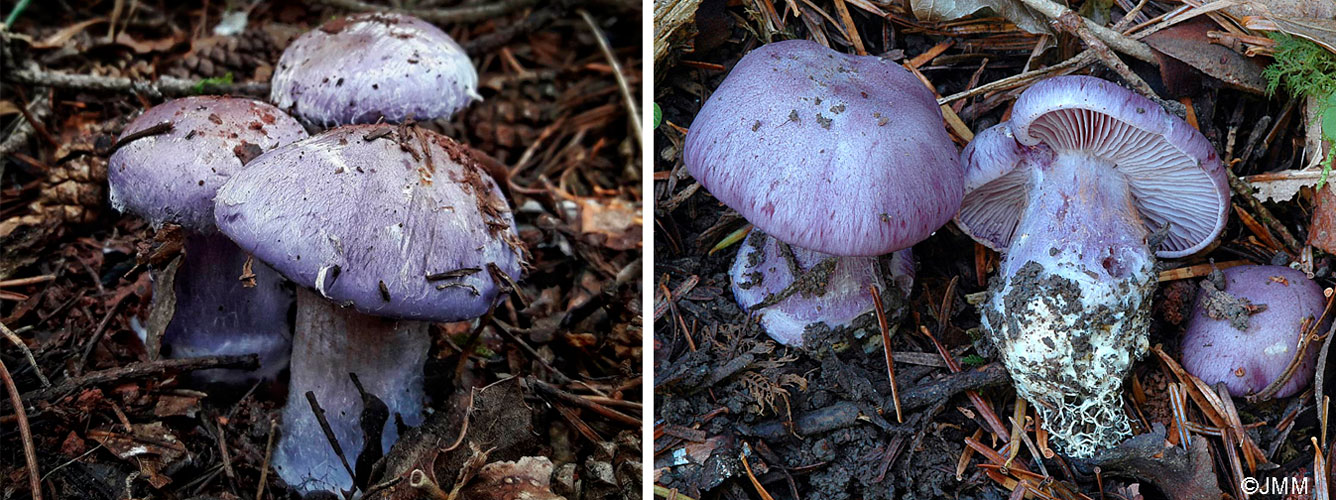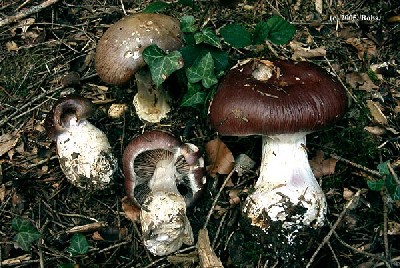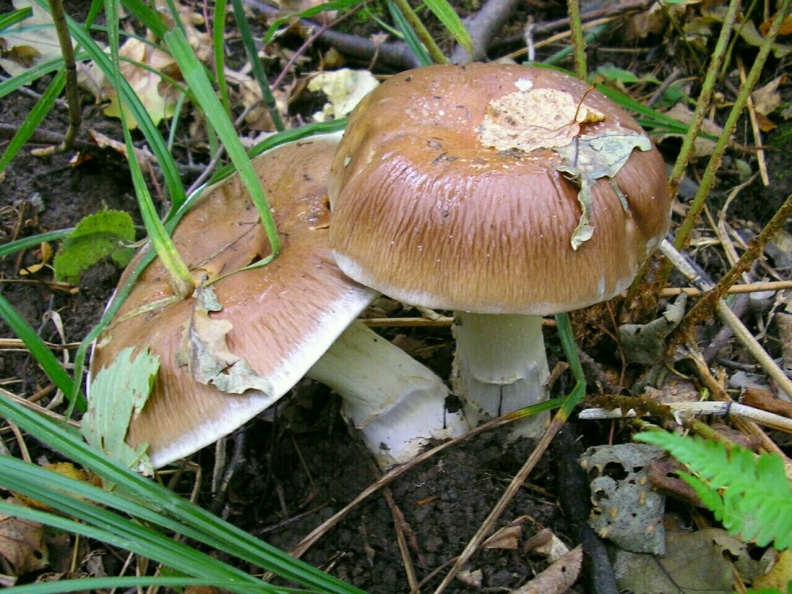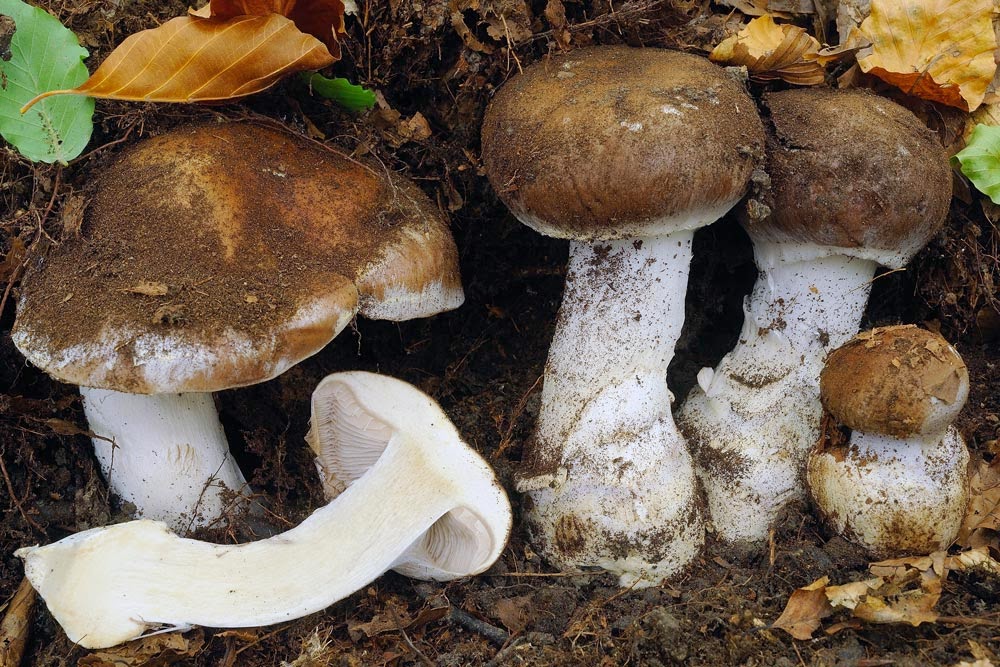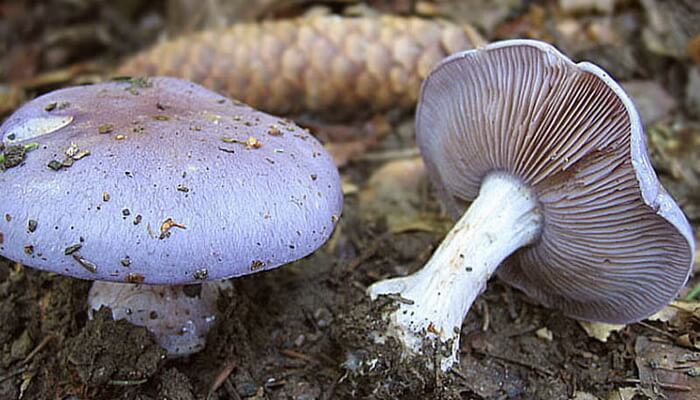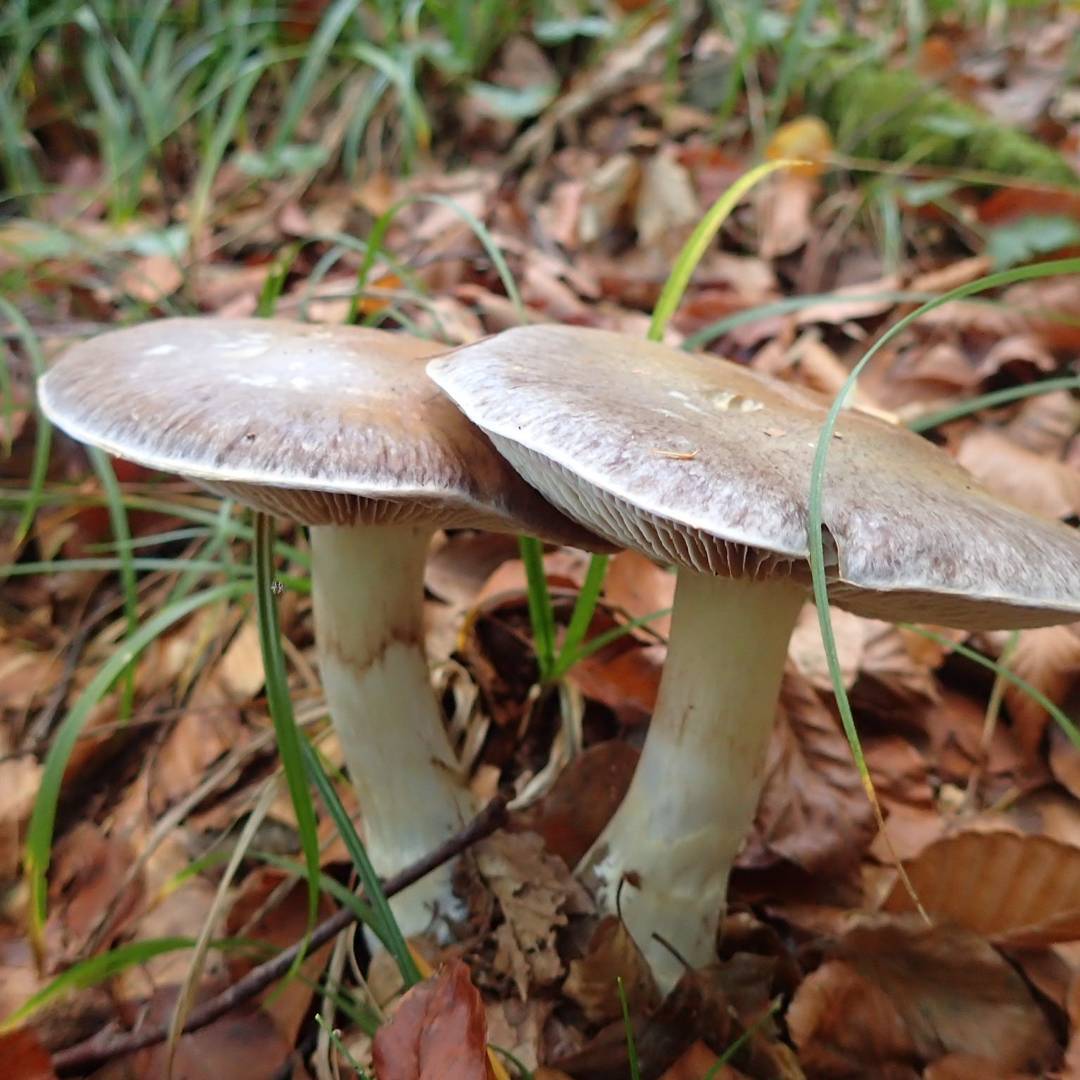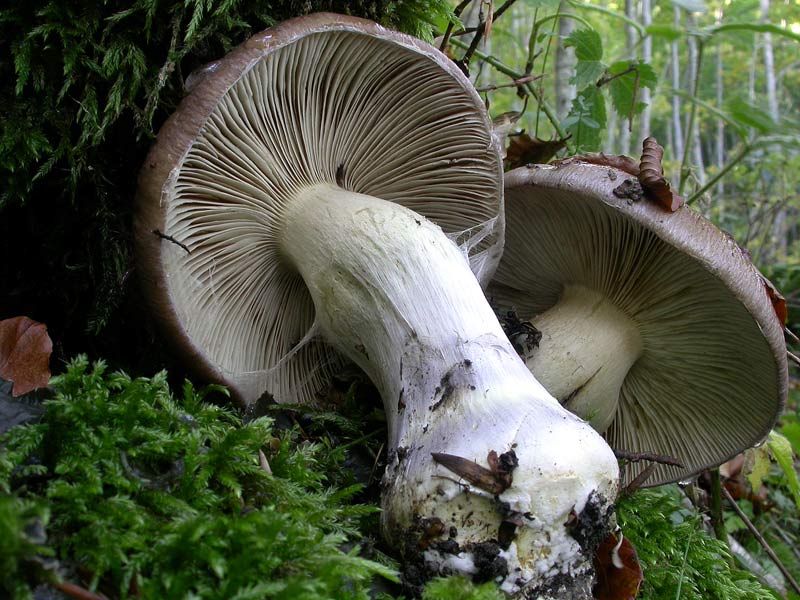Cinnamon webcap
The webcap is dark brown;
Cinnamon spiderweb (Cortinarius cinnamomeus) is a type of mushroom belonging to the Spiderweb family, the Spiderweb genus. This mushroom is also called brown spider web, or dark brown spider web.
The brown webcap is also called the species Cortinarius brunneus (dark brown webcap), which is not related to this.
External description
The cinnamon webcap has a cap with a diameter of 2-4 cm, characterized by a hemispherical convex shape. Over time, the cap becomes open. In its central part there is a noticeable obtuse tubercle. The surface of the cap is dry to the touch, fibrous in structure, yellowish brownish brown or yellowish olive brown in color.
The mushroom stem is characterized by a cylindrical shape, initially well filled on the inside, but gradually becomes hollow. In girth, it is 0.3-0.6 cm, and in length it can vary from 2 to 8 cm. The color of the leg is yellowish-brown, lightening towards the base. The pulp of the mushroom has a yellow tint, sometimes turning into olive, it does not have a strong smell and taste.
The fungal hymenophore is represented by the lamellar type, consists of adherent yellow plates, gradually becoming brownish-yellow. In color, the plates are similar to a mushroom cap. They are thin in structure, often located.
Season and habitat
The cinnamon spider web begins to bear fruit in late summer and continues to harvest throughout September. Grows in deciduous and coniferous forests, widespread in the boreal zones of North America and Eurasia. Occurs in groups and singly.
Edibility
The nutritional properties of this type of mushroom are not fully understood. The unpleasant taste of the cinnamon spiderweb pulp makes it unfit for human consumption. This mushroom has several related species, which differ in their poisonousness. However, no poisonous substances were found in the cinnamon spider web; it is absolutely safe for human health.
Similar types and differences from them
One of the types of mushrooms similar to the cinnamon spider web is the saffron spider web. Their main difference from each other is the color of the hymenophore plates in young fruit chalk. In cinnamon cobweb, the plates have rich orange hues, and in saffron, the color of the plates tends to be more yellow. Sometimes there is confusion with the name of the cinnamon spider web. This term is often called a dark-brown spider web (Cortinarius brunneus), which is not even one of the species related to the described spider web.
An interesting fact is that the cinnamon spider web has the properties of dyeing materials. For example, with the help of its juice, you can easily dye wool in a rich burgundy red.
Edible spiderwebs
The first rule for those who are not looking for unnecessary difficulties in life can be formulated as follows: all mushrooms with a spider web are poisonous.
The second rule might sound like this: there are no edible cobwebs.
The third I would formulate as follows: they are still tasteless. In general, those who are not looking for difficulties do not lose anything.
Now we can talk about edible webcaps. Perhaps there are many. And probably: the genus Cortinarius is inexhaustible, as a well-known physical abstraction, and a significant part of it are mushrooms “in the body” - large, beautiful, fleshy, abundant. Even if we exclude from this series the cobwebs with suspicious names that hint at a certain smell, for example, goat cobwebs, goat cobwebs, camphor, the remainder will still be more than impressive. And if we add that the deadly poisonous representatives of this genus look, in general, so-so, they are puny and unappetizing, so it is not clear for what purpose people are poisoned with them, so if you do all these operations in your mind, you can come to unequivocal conclusion: you have to try.
And the first to try is the famous yellow webcap, or triumphant. He is very recognizable, there is a lot of him. He does not smell like a goat. It grows with a birch, especially often it can be found there (and then), where there is a black mushroom. A mixed spruce-birch forest is his native home.There is evidence that a very variable cobweb (Cortinarius trivialis) is often mistaken for a yellow spider web - at some stages of development they are extremely similar. It is curious that the edibility of the common cobweb is “not established”. But, apparently, they do eat without prescription. Although not necessary in theory.
By the way, justice requires admitting: a yellow spider web, pickled with a carnation, is quite good. The rare, collectible purple webcap is eaten for other reasons - precisely as a scarcity. (Remember? “Taste. Specific.”) Finding this rarity, sorting from dozens of other cobwebs painted in a similar way, and then eating - there is something solemn in this, something that disrupts the routine flow of mushroom reality.
And then there are “cousins of spider webs” - closely related mushrooms, allocated for some merit from the genus Cortinarius. There are few of them, but they are good. Bulbous webcap - a wonderful mushroom resembling a cobweb that imagined itself as a fly agaric - perfectly manifests itself in mushroomlessness. It can be fried like a champignon. The more popular ringed cap takes on a number. A large, very large number.
The remaining hundreds of potentially edible mushrooms of this genus are patiently waiting for the selfless natural scientist.
Yellow, or triumphant, is the most famous edible spider web. Many people collect it on purpose, and not out of despair. It is a large, abundant mushroom with firm flesh and no unpleasant odor common to many cobwebs. Ideal for long-lasting blanks (strong marinade with spices); amateurs use it boiled (lightly salted).
Purple webcap is a rare mushroom (although there are many purple webcaps, the rest are all smelly). Connoisseurs who have managed to find and distinguish this mushroom, first boil it (20 minutes), and then use it at their own discretion. You can marinate. However, it is probably better to leave this amazing mushroom in the forest.
The mushroom looks unpresentable, but the appearance is deceiving. It does not spoil the mushroom platter, it sounds dignified both in hot and in broth, and in marinade. A small number does not allow you to experience the white-webbed bulbous separately, but if we talk about mixing, then it can be fried with wild mushrooms without any boiling.
In countries with an undeveloped mushroom culture, the ringed cap is considered a delicacy mushroom. We have mostly toadstool. The truth is somewhere nearby: the mushroom tastes good and is great for harvesting. Salting, pickling is a sweet thing. It is also used lightly salted (boiled with salt, garlic, dill). The legs of adult mushrooms are harsh, it is better to remove them.
Simple options
For the construction of the hearth, you can use a variety of materials: bricks, large pebbles, boulders, various types of natural stone, concrete blocks, paving slabs. The most common option is using the most suitable material for this, brick.
For this role, both cinder block and ordinary bricks are suitable. It should be remembered that for laying out the walls it is better to use the widest possible brick of large sizes, capable of keeping heat well inside the hearth. For this, when laying out the hearth with perforated bricks, place holes in it towards the ground, and not parallel to it.
The amount of material required in order to make a hearth in the country is determined by the size of the fireplace being erected and its purpose. For example, if you plan to grill food on the hearth, then the hole under the hearth should be made deeper, which means that more material will be needed for its construction.
You can make a hearth for a fire much faster. Firstly, a lot of country or courtyard metal hearths are offered. All you need is a platform on which you put a metal fire pit.
A metal bowl is a quick way to decorate a campfire site
A very similar option is a concrete fire bowl. They are cast in different sizes, they are round or square.You can do exactly the same yourself, but you will have to wait at least a month. And you put the finished bowl, and you can use it.
Fast and hassle-free
The pig is thin: photo and description
Pig mushroom in the photo
Pig is a lamellar mushroom that grows in various types of forests in large groups, from July to October, it can form mycorrhiza. In recent years, the pig has been classified as a poisonous mushroom (it can cause poisoning, even fatal). It contains substances that lead to a decrease in red blood cells in the blood. Moreover, the manifestation of poisoning depends on the individual characteristics of the human body and can occur both a few hours later and several years after the use of these mushrooms.
Previously, the pig was considered an edible mushroom, it was even taken into government procurements. In all the old books, it is designated as an edible mushroom. Currently, views on her have changed. It turned out that the pig contains an antigen that causes the production of antibodies by the human immune system. Moreover, the effect of this antigen on the body depends on the susceptibility of each person. For some, excessive antibody production may occur, resulting in allergic shock. Signs of poisoning may appear after a few hours or several years, since the toxin can accumulate in the body. Kidney function is impaired, which can lead to death. Treatment is to maintain kidney function.
The pig is thin in the photo
The slender pig (Paxillus involutus) is a lamellar mushroom, in some sources referred to as a pig's ear or dunka. Grows singly, in small groups or in numerous colonies from mid-June to early November, easily tolerating the fall in temperature. Grows in deciduous, mixed and coniferous forests, parks and gardens. In autumn, in the willow groves, you can find a lot of pigs.
Favorite habitats are wet areas of soil in lowlands and near swamps, woodlands, parks, vegetable gardens, as well as fallen tree trunks.
The mushroom is considered poisonous.
The cap is 5-15 cm in diameter, in young specimens it is convex, fleshy, light olive or greenish-beige, with a strongly tucked edge, with dense, thick light pulp, then open, with a depressed center, yellow-brown or gray-brown ...
The plates are descending, soft, branched, yellow-buffy.
As you can see in the photo, a thin pig has a cylindrical leg, thinned downwards, 3-8 cm long and 1-2 cm thick, velvety, of the same color with a cap:
The pulp is thick, soft, elastic in young mushrooms, loose, pale brown in mature ones, brown in old mushrooms, darkens on the cut. The smell of the pulp is pleasant, the taste is sour.
Fruiting from July to November.
Until the early 80s of the last century, the slender pig was considered an edible mushroom, but after cases of mass poisoning were noted in several countries at once, doctors unanimously attributed it to the category of poisonous. It turned out that as a result of the frequent consumption of this variety of pigs in the human body, there is an accumulation of antibodies that destroy red blood cells. This, in turn, leads to serious kidney problems. In addition, it turned out that the slender pig easily accumulates heavy metals in its tissues, which also have a destructive effect on the human body.
According to the description, this pig cannot be confused with other mushrooms.
The webcap is excellent
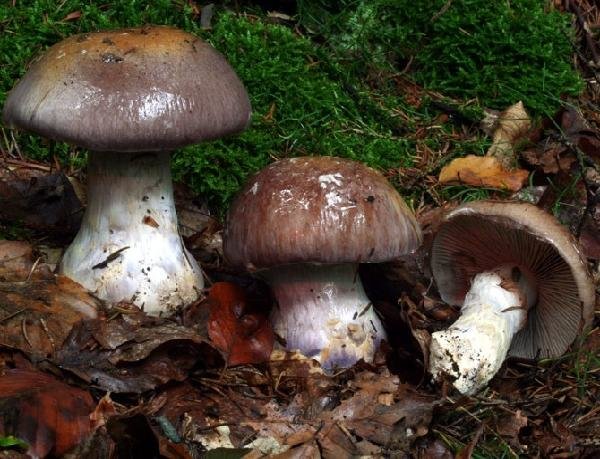
The excellent webcap (Cortinarius praestans) is a mushroom belonging to the Spiderweb family.
External description
The fruit body of the excellent spider web is lamellar, consisting of a cap and a leg. On the surface of the mushroom, you can see the remains of a spider web.
The diameter of the cap can reach 10-20 cm, and its shape in young mushrooms is hemispherical. As the fruit bodies ripen, the cap opens to a convex, flat, and sometimes even slightly depressed cap.The surface of the mushroom cap is fibrous and velvety to the touch; in mature mushrooms, its edge becomes pronouncedly wrinkled. In immature fruit bodies, the color is close to purple, and in ripe ones it becomes red-brown and even wine. At the same time, a purple tint is preserved along the edges of the cap.
The hymenophore of the fungus is represented by plates located on the back of the cap and adhered to the surface of the stem with their notches. The color of these plates is grayish in young mushrooms, and beige-brown in mature ones. The plates contain a rusty-brown spore powder consisting of almond-shaped spores with a warty surface.
The length of the leg of the excellent spider web varies within 10-14 cm, and the thickness is 2-5 cm. At the base, a tuberous thickening is clearly visible on it, and the remains of the cortina are clearly visible on the surface. The color of the leg in immature excellent spiderwebs is represented by a pale purple tint, and in mature fruit bodies of this species it is pale ocher or whitish.
The pulp of the mushroom is characterized by a pleasant aroma and taste; it acquires a brown color in contact with alkaline products. In general, it has a white, sometimes bluish color.

Season and habitat
The excellent webcap (Cortinarius praestans) is widespread in the nemoral areas of Europe, but is rare there. Some European countries have even included this type of mushroom in the Red Book as rare and endangered. The fungus of this species grows in large groups, lives in mixed and deciduous forests. May form mycorrhiza with beech or other deciduous trees growing in the forest. It often settles near birches, begins to bear fruit in August and gives good yields throughout September.
Edibility
The superb webcap (Cortinarius praestans) is an edible but little-studied mushroom. It can be dried, and also can be eaten salted or pickled.
Similar types and differences from them
The excellent spider web (Cortinarius praestans) has one similar species - the watery blue spider web. True, in the latter, the cap has a bluish-gray color and a smooth edge, covered with a cobweb cortina.
Mushroom photo The webcap is excellent from questions in recognition:
Review of purchased kits
Ready street hearth
Campfire bowls and ready-made fireplaces are the optimal solution for the gardener who can afford such a purchase. Unfortunately, pleasure is not cheap. But if the budget allows, you can choose stunning designs.
In the assortment of special shops with equipment for summer cottages, there are cast-iron or ceramic hearths, barbecues, tandoors, beautiful spheres, bowls, ready-made designs of a street hearth, fire barrels and other vessels.
Bowls and spheres
Bonfire sphere
Bowls and spheres
- They are a hit of sales. They have different diameters, depths, and are made of different alloys. Some are suitable for grilling.
- They are rounded compositions with metal carvings on a low or high base. The set includes covers, protective glasses, tongs for turning coals.
- The price range varies in the corridor from 7 thousand rubles. for an ordinary concrete bowl, up to 150 thousand rubles. for a unique design idea.
Street hearths
Classic finished design
Street hearths
- These are ready-made structures for installation in a specific location. They are not tolerated, not disassembled, used only for their intended purpose. The structure is dug into the ground, strictly following the instructions.
- Made of high quality metal, beautifully decorated.
- The cost of a ready-made fireplace starts at 80 thousand rubles.
Fire barrel
Braziers
Stylish barbecue design
Braziers
- For cooking meat or vegetables on skewers. The most convenient shape is rectangular, depth - from 25 cm.
- There are usually notches on the upper walls of the vessel for the installation of iron spokes.
- A simple, laconic product will cost 3-5 thousand, but the upper limit is even more than 100 thousand.
Cauldron with a frying pan lid
Cooking utensils over a fire
Tandoors, cauldrons, pans, cast irons, flat stones for baking. These are utensils for outdoor cooking. It is a pleasant bonus to the complete set of a summer cottage.
The cost of containers depends on their volume, the manufacturer's firm, and the quality of the metal. The average price for a 15-liter cauldron for pilaf with a lid is 4-5 thousand rubles.
Avid gardeners over time become overgrown with useful accessories, outdoor cooking utensils, folding furniture
They even pay attention to small things, such as all kinds of lattices, tongs, hooks for hanging. Think over a design, which includes a decorative woodpile, bright blankets, mosquito nets.
Description of the appearance of the webcap excellent.
The fruit body of an excellent spider web consists of a stem and a cap. Remnants of a cobweb blanket are visible on the surface of the hearth body. At a young age, the shape of his cap is hemispherical, then it opens up to convex, and sometimes even to a depressed one. Its surface is 10-20 centimeters.

The surface of the cap of the excellent spider web is fibrous and velvety. In mature specimens, the edges of the cap become wrinkled. At a young age, the color of the caps is almost purple, and later it becomes reddish-brown or wine, but the purple tint remains at the edges.
The superb webcap is a lamellar fungus. The plates are located on the back of the cap. They grow in grooves to the surface of the leg. The color of the plates in young specimens is grayish, and later it becomes beige-brown. The plates contain a rusty-brown powder. Spores are almond-shaped, their surface is warty.

The flesh of the excellent cobweb has a pleasant taste and aroma. The color of the pulp is white, sometimes with a bluish tinge, and upon contact with alkali, it becomes brown.
The stem is tuberous, with a noticeable thickening at the base. It is long - 10-14 centimeters in height, and thick - 2-5 centimeters in girth. The leg is even in shape. The remains of the bedspread are clearly visible on its surface. In immature fruiting bodies, the color of the stem is pale purple, and in mature specimens it becomes whitish or pale ocher.

How to properly cover lilies for the winter
In most cases, it is not required to additionally cover garden lilies, they need a natural snow cover with a layer of 10 cm or more. But how to keep the lilies in winter, when there is still no snow cover or it is very weak and the frosts are strong? In these cases, it is better to cover the planting of lilies with dry peat, fallen leaves or needles.
You need to remove the winter shelter on time - as the snow melts. If you remove the shelter too late, due to the lack of light, the lilies will give very thin sprouts that hardly break through the foliage. Harvesting the mulch too early stimulates the strong growth of lilies, as a result of which delicate sprouts may be damaged by frost.
Many experienced flower growers leave in their flower gardens and Oriental hybrids of lilies, which do not differ in good winter hardiness. The success of wintering these species depends entirely on how to prepare lilies for winter, taking into account their characteristics. The fact is that Eastern hybrids are not recommended to be left in the flower garden for the winter, not because they freeze out, but because they get wet under deep snowdrifts and suffer from excessive moisture in the spring. Therefore, if you are wondering how to preserve lilies for the winter, you need to make sure that they winter in fairly dry conditions.
How to keep lilies of Oriental hybrids:
- plant Oriental hybrids in elevated flower beds;
- pour sand into each hole and sprinkle the planting material on top with sand, and only then with soil;
- cover the lilies with peat in the fall;
- after the ground freezes, sprinkle the peat with fallen leaves;
- cover the planting with foil.
Their further development and flowering largely depends on how lilies winter.Therefore, try to provide your pets with comfortable wintering conditions in accordance with the specific features, and they will certainly thank you with lush flowering next season!
If growers leave their flowers to winter in the open field, then before the onset of cold weather, most of them should be covered. You can leave these flowers without shelter if the winters are mild in the region (for example, in the South of Russia), and the varieties are highly frost-resistant.
In principle, if lilies do not grow in the conditions of the Far North (and close to them in climatic conditions), then many varieties and hybrids can be left in flower beds for the winter:
- Asian (tiger) hybrids;
- Martagon (curly);
- Candidum;
- Tubular;
- hybrids Longiflorum Asiatic (LA),
- OT hybrids;
- Royal;
- Daurskys.
All of the above varieties feel great in the garden in winter, only they should be covered in case of severe frosts.
Shelter is necessary only for long-flowered, oriental and American lily hybrids.
Usually, lilies do not need special shelter if a large amount of snow falls in the region in winter, which will cover the bulbs during the winter. If there is little snow or the winter will be warm, then care should be taken in advance to prepare a natural covering material. It is best to use needles (pine or spruce sawdust, or spruce branches), under which slugs and other "harmful" insects will not crawl, as well as pests (especially mice) that can damage the growth points of bulbous plants.
Edible mushrooms, berries, herbs
Orange-red webcap (Cortinarius orellanus)
The orange-red webcap is also called a plush webcap or a mountain webcap. You can meet him from the last decade of August to the last decade of October in broad-leaved (where there is a birch oak) and coniferous forests. It prefers to grow singly and in groups on sandy soil. More common in the southern regions of Russia.
The hat is from 4 to 8 cm in diameter, at first it has a hemispherical shape, then it is convex-outstretched or flat with a lowered edge. The surface is dry, matte, felt, fine-flaked, orange-red-brown in color with a darker center. There is a small tubercle in the central part of the cap.
The plates are sparsely located, wide, thick, adherent have a color similar to the color of the cap. On very young specimens, there is a cobweb cover of a yellowish-ocher color, which disappears very early.
The leg is cylindrical, sometimes slightly narrowed towards the base, 5-10 cm long and up to 2 cm in diameter. The structure is longitudinally fibrous (covered with dark fibers inherited from a torn bedspread), without belts, has a light yellow color on the main part. Above, the leg is lemon-yellow, at the base it is rusty-brown.
The pulp is yellowish-brown, tasteless, with a faint unpleasant odor, vaguely resembling a radish.
The orange-red webcap is recognized as a deadly poisonous mushroom. Its main insidiousness lies in the fact that the main symptoms of poisoning appear 5-14 days after consumption. Poisonous toxins (orellanins) are completely retained during cooking, frying or drying. The first symptoms of poisoning are unbearable thirst, then sharp pains in the abdomen appear, later pathological changes in the work of the kidneys occur. If the poisoned person is lucky and survived, then further treatment can last up to a year or more.
The mountain webcap can be confused with similar types of brown-red webcaps: the most beautiful poisonous webcap, brown webcap, dark brown webcap, edible bracelet. Since even edible species do not taste good, it is better to refuse to eat all more or less suspicious specimens.
Photos of orange-red spiderweb (Cortinarius orellanus)
To better recognize this poisonous mushroom, it does not hurt to watch the video of the Italian Mycological Association about the Orange-red Webcap




